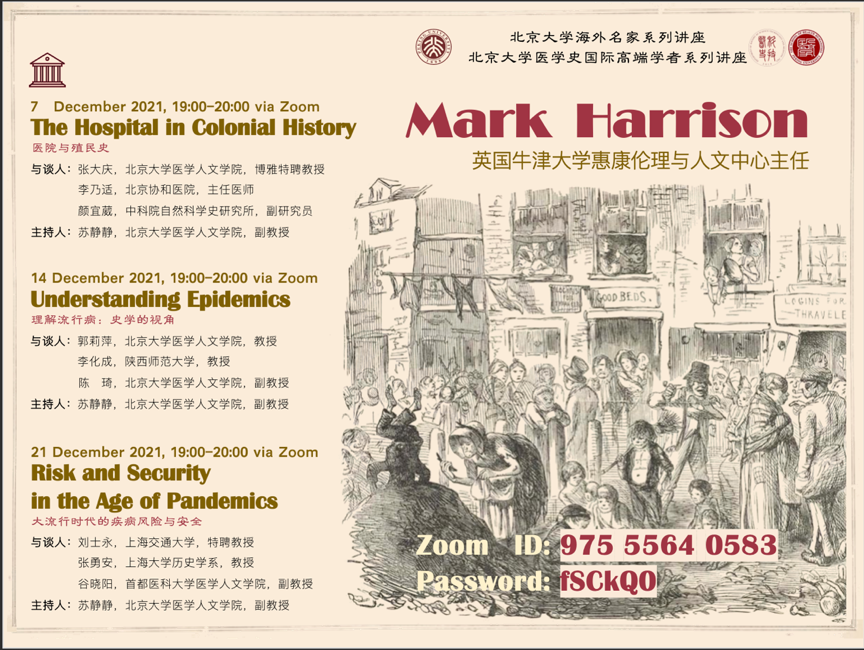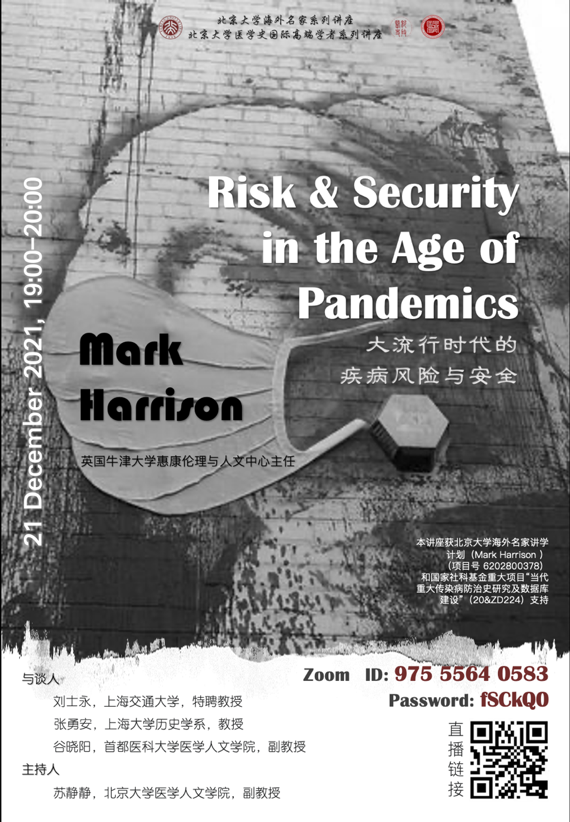Peking University Distinguished Lectureship & Global Health History Lectures: Prof. Mark Harrison Ⅲ:Risk and Security in the Age of Pandemics
With the support of Peking University Distinguished Lectureship (北京大学海外名家讲学计划) and Chinese National Social Science Foundation Major Project of the “Contemporary Historiography and Database Construction of Epidemics” (PI), Professor Mark Harrison was invited to give a series of three online lectures around themes of great concern on the history of global health in December of 2021. Mark Harrison is the professor of history, co-director of the Wellcome Centre for Ethics and Humanities, University of Oxford, UK.
The series of Global Health History Lectures were chaired by Prof Su Jingjing, associate professor of the School of Medical Humanities of Peking University, and organized under the titles of "The Hospital in Colonial History"(December 7,2021), "Understanding Epidemics: a Historical Perspective" (December 14,2021) and "Risk and Security in the Age of Pandemics" (December 21,2021), respectively.

On December 21, 2021, Professor Mark Harrison gave the third wonderful online lecture on “ Risk and Security in the Age of Pandemics ”. The lecture was chaired by Professor Zhang Daqing(张大庆)from Peking University. For the discussion session, Professor Liu Shiyong(刘士永)from Shanghai Jiao Tong University, Professor Zhang Yongan from Shanghai University, and Associate Professor Gu Xiaoyang from Capital Medical University were invited to have a dialogue around this particular topic.

1. Introduction
We are in a new ‘age of pandemics’, and revisiting the risks and security of the pandemics era will help us to understand the Covid-19 pandemic and the current international situation. Professor Mark Harrison believes that risks are responses to insecurity, in essence, they are relative truths (probabilistic), and there is no objective standard to against which risks can be validated. Even in different countries or cultural backgrounds, the perception of risks is different. The modern concept of "pandemic" is the product of "risk society", especially the product of "world risk".
The concept of "pandemic" produced in this context has both advantages and disadvantages for human society. Risk calculations tell us where threats may lie so that they can be mitigated. However, other factors may be overlooked due to specific solutions. Staging of pandemic as a risk phenomenon can normalize certain causal factors (inevitable). Therefore, risk creates a new basis for social interaction (risk literacy) and public health, but it can be social division and stigmatization.
Sometimes risk calculations can support people to do better, but fear of risk is a natural human emotion, and the abuse of this emotion will distort the results of risk calculations. Professor Mark Harrison believes that there are always blind spots in the illusion of security based on risk assessment, which is easy to lead to fallacy of prediction. Therefore, although risk analysis is important and useful in public health and pandemic prevention, it still needs to be supplemented by a sense of collective responsibility at the national and international levels.
2. Pandemics in a world before risk
Professor Mark Harrison first discriminated the concept of "pandemic". In modern public discourse and scientific discourse, the "pandemic" is vague and changing. In a word, it is "infectious disease that exists on more than one continent and incidence rate exceeds statistical standards. According to the Oxford English Dictionary, this concept has more diverse explanations, not only referring to emotional vulgar or sensual love, but also generally disease (or something else) prevalent throughout a country, continent or the world; it is defined as "an epidemic occurring worldwide or over a very wide area, crossing international boundaries, and usually affecting a large number of people" in the Oxford Dictionary of Epidemiology ; the WHO has no precise definition but a ‘definition-description’ of ‘pandemic’, which is regularly subject to change.
The global spread of cholera made the term "pandemic" more closely related to infectious diseases. However, the concept of "pandemic" was not often used until the mid-19th century, when the development of navigation technology made the world more closely linked by diseases. The Russian flu of 1889-1891 and the third plague epidemic made this concept widely known. The epidemic of Russian flu occurred when the paper media like newspapers and telegrams rose, and the epidemic of the third plague occurred when photography technology was widely respected as the visual media. The popularization of media technology makes people feel more strongly about the "pandemic" and produce a sense of imminent threat.
3. Remaking pandemics as risk phenomena
In the 1960s and 1970s, telegraph stations have widely existed all over the world. They have been used to report diseases and provide support for national public health institutions. The early warning of "pandemic" has become possible. However, at this time, it is only a preventive measure to protect certain parts of the world from infringement, such as the canal shipping supervision system established in Suez Canal and other places. At the time, the treatment methods of various countries are still lack of coordination.
It was not until the beginning of the 20th century that preventive measures were coordinated through international legislation. The landmark event that "pandemic" prevention began to be constructed as a risk related phenomenon was the 1918-1919 pandemic influenza. This period also saw the first concerted action by groups of nations and other agencies. After the end of the first World War, the prevention of "pandemic" has also become an important part of the League of Nations’ Epidemics Commission. For example, during the war between Greece and Turkey in 1922, the Epidemic Committee coordinated the national state and voluntary organizations, including the Greek Red Cross, to make joint efforts to prevent the epidemic of smallpox and typhus.
In the late 20th century, the idea of risk analysis through the background of pandemic has been quite mature. For example, during World War II, out of concern about the influenza outbreak after World War I, the U.S. military established the influenza Committee in 1941 to carry out vaccine development and risk assessment, to determine the possibility of influenza outbreak. Risks are gradually distorted into predictions. Based on risk assessment and statistical analysis, there will be an influenza pandemic about every 10-11 years. Therefore, although there was no other influenza after the outbreak of influenza in 1957, the United States still launched a large-scale vaccination in 1976. Finally, the side effects of the vaccine and the influenza that did not arrive "as scheduled" shook the theory of " predictable pandemic".
4. ‘Securitization’ of pandemic
Pandemics had always been seen largely in terms of national security. After the Second World War, the reduction of global pandemics made people pay less attention to its threat. However, the spread of AIDS in 1980s re-awakened interest in pandemics as security issues. For example, the US National Intelligence Council said in its briefing that infectious diseases, on the one hand, pose a threat to the health of overseas troops, on the other hand, they will undermine national stability and interests. All this shows that infectious diseases have once again become a national security problem.
In addition to AIDS, other forms of infectious diseases are also constantly causing people to analyze the relationship between "pandemic" and national security risks. Ebola virus is considered to exist mainly in marginalized populations and states with failed management. Although there are differences in how to deal with this "emerging disease" in the western public health community, it still focuses on assessing regional risks through monitoring, so as to control the spread of the disease geographically. Obviously, this approach can not completely quell the outbreak and spread of Ebola in Africa and other places.
After the outbreak of SARS, people tried to untie the link between disease and national security, but at this time, the understanding of "security" has undergone subtle changes. The 9.11 incident has incorporated the virus into the national security investigation system. The state is considered to have an obligation to control bacteria. Professor Mark Harrison believes that many countries try to master all strains through technology and find treatments to create a ‘global immune system’, but this is difficult to achieve.
In 2009, H1N1(swine flu) and Ebola epidemic in West Africa show the limitations of risk analysis in the field of public health. The risk brought by the disease has been exaggerated. With the spread of the disease all over the world, the initial disease risk has shifted to the economic field, and the fractures in the international community and the failure of public health messaging based on risk have gradually emerged. Due to the wrong risk rating of Ebola epidemics, so that its threat to public health was once despised, which exacerbated its threat to public health.
5. Conclusions
Surveillance and containment of disease are vital elements of global public health. But the existing risk analysis is basically carried out by the nation-state and other organizations. However, there are differences in the ability of disease prevention in different countries, so there are always some loopholes in the existing risk analysis; The risk assessment related to the long-standing disputes over global trade issues and the disease threat of meat and plants is also controversial; Differences within countries and stigmatization in some regions are also blind spots in risk analysis. Therefore, global health needs a wider conception of security which allows risk analyses to examine hitherto neglected aspects such as societal tensions, culture, etc. These loopholes, disputes and blind spots also need a sense of collective responsibility beyond risk analysis or at least complementary.
The current Covid-19 also shows that risks have been interpreted differently by different people and nations. Even in the same country, people living in different cultural backgrounds have very different understanding of risk, and risk analysis needs to be supplemented and improved. Forming a collective sense of collective responsibility is an effective way to deal with the Covid-19 virus. It is not only a sense of collective responsibility at the national level, but also a multi-level interaction, such as cooperation between civil society and governments at all levels and various kinds of organizations. This sense of collective responsibility is essential to prevent social fragmentation and restore international trust.
Professor Mark Harrison’s wonderful lecture was well received by the experts, scholars and students attending the meeting. During the discussion and Q&A sessions, Prof. Liu Shiyong, Prof. Zhang Yongan and Associate Prof. Gu Xiaoyang discussed the public information problems in epidemic surveillance, the difference in prevention and control of global Covid-19, and the ‘risks’ in bio-medicine.
Professor Mark Harrison’s lecture was highly and widely appreciated. It was live webcast on the platform of BiliBili, attracting thousands of international viewers and very positive feedback from scholars and students.
Wang Xinyue, Su Jingjing;School of Health Humanities


